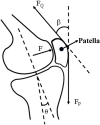Effects of different sensory integration tasks on the biomechanical characteristics of the lower limb during walking in patients with patellofemoral pain
- PMID: 39257445
- PMCID: PMC11383783
- DOI: 10.3389/fbioe.2024.1441027
Effects of different sensory integration tasks on the biomechanical characteristics of the lower limb during walking in patients with patellofemoral pain
Abstract
Purpose: This study aimed to analyze the biomechanical characteristics of the lower limb in patients with patellofemoral pain (PFP) while walking under different sensory integration tasks and elucidate the relationship between these biomechanical characteristics and patellofemoral joint stress (PFJS). Our study's findings may provide insights which could help to establish new approaches to treat and prevent PFP.
Method: Overall, 28 male university students presenting with PFP were enrolled in this study. The kinematic and kinetic data of the participants during walking were collected. The effects of different sensory integration tasks including baseline (BL), Tactile integration task (TIT), listening integration task (LIT), visual integration task (VIT) on the biomechanical characteristics of the lower limb were examined using a One-way repeated measures ANOVA. The relationship between the aforementioned biomechanical characteristics and PFJS was investigated using Pearson correlation analysis.
Results: The increased hip flexion angle (P = 0.016), increased knee extension moment (P = 0.047), decreased step length (P < 0.001), decreased knee flexion angle (P = 0.010), and decreased cadence (P < 0.001) exhibited by patients with PFP while performing a VIT were associated with increased patellofemoral joint stress. The reduced cadence (P < 0.050) achieved by patients with PFP when performing LIT were associated with increased patellofemoral joint stress.
Conclusion: VIT significantly influenced lower limb movement patterns during walking in patients with PFP. Specifically, the increased hip flexion angle, increased knee extension moment, decreased knee flexion angle, and decreased cadence resulting from this task may have increased PFJS and may have contributed to the recurrence of PFP. Similarly, patients with PFP often demonstrate a reduction in cadence when exposed to TIT and LIT. This may be the main trigger for increased PFJS under TIT and LIT.
Keywords: biomechanical of the lower limb; gait; patellofemoral joint stress; patellofemoral pain; sensory integration task.
Copyright © 2024 Ting and Zeyi.
Conflict of interest statement
Author FT was employed by Shanghai Zhuoyue Ruixin Digital Technology company limited. The remaining author declares that the research was conducted in the absence of any commercial or financial relationships that could be construed as a potential conflict of interest.
Figures







Similar articles
-
Patellofemoral joint stress during running in females with and without patellofemoral pain.Knee. 2012 Oct;19(5):703-8. doi: 10.1016/j.knee.2011.09.006. Epub 2011 Oct 13. Knee. 2012. PMID: 22000909
-
Acute effects of negative heel shoes on perceived pain and knee biomechanical characteristics of runners with patellofemoral pain.J Foot Ankle Res. 2024 Mar;17(1):e12001. doi: 10.1002/jfa2.12001. J Foot Ankle Res. 2024. PMID: 38551203 Free PMC article.
-
Influence of foot strike patterns and cadences on patellofemoral joint stress in male runners with patellofemoral pain.Phys Ther Sport. 2024 Jan;65:1-6. doi: 10.1016/j.ptsp.2023.10.006. Epub 2023 Nov 9. Phys Ther Sport. 2024. PMID: 37976905
-
Kinematic and Kinetic Gait Characteristics in People with Patellofemoral Pain: A Systematic Review and Meta-analysis.Sports Med. 2023 Feb;53(2):519-547. doi: 10.1007/s40279-022-01781-1. Epub 2022 Nov 5. Sports Med. 2023. PMID: 36334239
-
Age-Dependent Patellofemoral Pain: Hip and Knee Risk Landing Profiles in Prepubescent and Postpubescent Female Athletes.Am J Sports Med. 2018 Sep;46(11):2761-2771. doi: 10.1177/0363546518788343. Epub 2018 Aug 9. Am J Sports Med. 2018. PMID: 30091937 Free PMC article.
References
LinkOut - more resources
Full Text Sources

